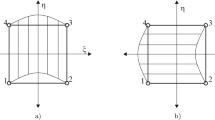A computational model describing crack formation in a fibrous composite is developed. It is assumed that, upon repeated loading, crack formation in the composite leads to its fracture. Determination of the unknown parameters characterizing an initial crack is reduced to solving a singular integral equation. A closed system of nonlinear algebraic equations whose solution allows one to predict crack formation in the composite depending on the geometric and mechanical characteristics of the binder and fiber is constructed. A crack initiation criterion for the composite is formulated.






Similar content being viewed by others
References
L. Mishnaevsky and P. Brøndsted, “Micromechanical modeling of damage and fracture of unidirectional fiber reinforced composites: A review,” Comput. Mater. Sci., 44, 1351-1359 (2009).
N. Lü, X. Li, Y. Cheng, and J. Cheng, “An asymmetrical dynamic crack model of bridging fiber pull-out of composite materials,” Fibers and Polymers, 12, 79-88 (2011).
R. A. Chaudhuri, “Three-dimensional singular stress field at the front of a crack weakening a unidirectional fiber reinforced composite plate,” Compos. Struct., 93, 513-527 (2011).
Y. F. Ko and J. W. Ju, “Effects of fiber cracking on elastoplastic-damage behavior of fiber-reinforced metal matrix composites,” Int. J. Damage Mech., 22, 48-67 (2013).
M. Usal, “On continuum damage modeling of fiber reinforced viscoelastic composites with microcracks in terms of invariants,” Math. Probl. Eng., 2015, ID 624750, 15 (2015).
F. Greco, L. Leonetti, and P. Lonetti, “A two-scale failure analysis of composite materials in presence of fiber/matrix crack initiation and propagation,” Compos. Struct., 95, 582-597 (2013).
R. Brighenti, A. Carpinteri, A. Spagnoli, and D. Scorza, “Continuous and lattice models to describe crack paths in brittle-matrix composites with random and unidirectional fibers,” Eng. Fracture Mech., 108, 170-182 (2013).
A. Afshar, A. Daneshyar, and S. Mohammadi, “XFEM analysis of fiber bridging in mixed-mode crack propagation in composites,” Compos. Struct., 125, 314-327 (2015).
B. D. Le, F. Dau, J. L. Charles, and I. Iordanoff, “Modeling damages and cracks growth in composite with a 3D discrete element method,” Composites: Part B., 91, 615-630 (2016).
K. Woo, “Fracture analysis of woven textile composite using cohesive zone modeling,” J. Mechanical Sci. Techn., 31, 1629-1637 (2017).
V. M. Mirsalimov and F. F. Hasanov, “Interaction of a periodic system of foreign elastic inclusions whose surface is uniformly covered with a homogeneous cylindrical film and two systems of straight line cracks with end zones,” J. Machinery Manufacture and Reliability, 43, 408-415 (2014).
V. M. Mirsalimov and F. F. Hasanov, “Interaction between periodic system of rigid inclusions and rectilinear cohesive cracks in an isotropic medium under transverse shear,” Acta Polytechnica Hungarica., 11, Iss. 5, 161-176 (2014).
V. M. Mirsalimov and F. F. Hasanov, “Nucleation of cracks in an isotropic medium with periodic system of rigid inclusions under transverse shear,” Acta Mech., 226, 385-395 (2015).
O. F. Ibraheem, B. H. Abu Bakar, and I. Johari, “Behavior and crack development of fiber-reinforced concrete spandrel beams under combined loading: an experimental study,” Struct. Eng. Mech., 54, 1-17 (2015).
W. Hao, X. Yao, Y. Ma, and Y. Yuan, “Experimental study on interaction between matrix crack and fiber bundles using optical caustic method,” Eng. Fracture Mech., 134, 354-367 (2015).
L. Li, “Modeling matrix fracture in fiber-reinforced ceramic-matrix composites with different fiber preforms,” Textile Res. J., 90, Iss. 7-8, 909-924 (2020).
V. M. Mirsalimov and V. A. Askarov, “Minimization of fracture parameters of a composite at bending,” Mech. Compos. Mater., 51, No. 6, 737-744 (2016).
V. M. Mirsalimov and Sh. G. Hasanov, “Minimization of the stress state and fracture parameters of a composite in bending,” Mech. Compos. Mater., 55, No. 5, 627-636 (2019).
L. Li, “Synergistic effects of fiber/matrix interface wear and fibers fracture on matrix multiple cracking in fiber-reinforced ceramic-matrix composites,” Compos. Interfaces., 26, Iss. 3, 193-219 (2019).
V. V. Panasyuk, Mechanics of Quasi-Brittle Destructions of Materials [in Russian], Kiev, Naukova Dumka (1991).
V. M. Mirsalimov, Non-One-Dimensional Elastoplastic Problems [in Russian], M., Nauka (1987).
A. Rusinko and K. Rusinko, Plasticity and Creep of Metals, Springer Verlag, Berlin Heidelberg, Germany (2011).
V. M. Mirsalimov, “Initiation of crack-type defects the bushing of a contact pair,” Mathematical Modelling, 17, No. 2, 35-45 (2005).
V. M. Mirsalimov and N. M. Kalantarly, “Cracking in a circular disk under mixed boundary conditions,” Acta Mechanica, 226, Iss. 6, 1897-1907 (2015).
N. I. Muskhelishvili, Some Basic Problems of the Mathematical Elasticity Theory [in Russian], M., Nauka (1966).
V. V. Panasyuk, M. P. Savruk, and A. P. Datsyshin, Distribution of Stresses around Cracks in Plates and Shells [in Russian], Kiev, Naukova Dumka (1976).
Author information
Authors and Affiliations
Corresponding author
Additional information
Translated from Mekhanika Kompozitnykh Materialov, Vol. 56, No. 6, pp. 1047-1066, November-December, 2020.
Rights and permissions
About this article
Cite this article
Mirsalimov, V.M. Modeling the Initiation and Propagation of Cracks in a Fibrous Composite Under Loading Across Fibers. Mech Compos Mater 56, 721–734 (2021). https://doi.org/10.1007/s11029-021-09918-5
Received:
Accepted:
Published:
Issue Date:
DOI: https://doi.org/10.1007/s11029-021-09918-5




